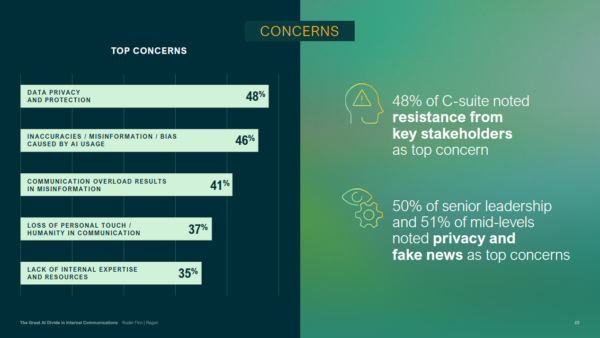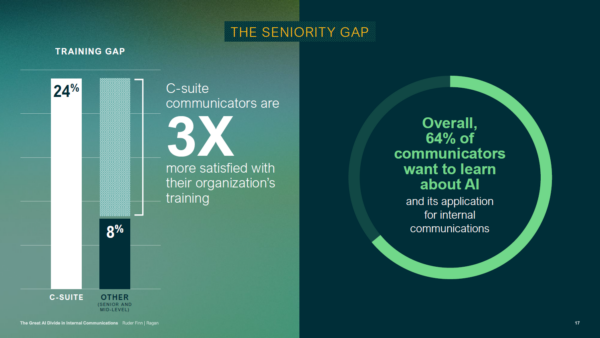6 ways communicators can influence the AI budgeting process
Your team will be using AI. Here’s how to take some control.

This is part three in Ragan’s series on budgeting for communicators. Read part one here and part two here.
When you gain influence, you secure budget. Similarly, the rapidly-accelerating applications of AI open unrealized opportunities for communicators to influence the safe, responsible and practical implementation of the tech across business lines.
AI will benefit those closest to the business, and becoming closer to the business is the best way to gain influence. To this end, it stands to reason that communicators should seek to allocate spend for operational AI tools.
This requires documenting and demonstrating impact, which is hard to do with new tech when you lack benchmarks and baselines. In the absence of this, Catherine Richards, founder of Expera Consulting and AI coach to Ragan Communications Leadership Council members, suggests focusing on the strengths and differentiations that are unique to comms.
“The differentiation is a trust catalyst,” Richards said, “because communications generally leads the relationships with investors, analysts and media.”
“Relationships are your secret sauce,” she continued. “Other functions don’t have those, and so communicators can build that trust. You have to be transparent there. You guard the reputation. Many times you are the navigator for the ethics. Lean in there.”
Ragan and Ruder Finn’s recent survey of AI in internal communications underscores how important trust is to scaling AI implementation across the business — 50% of senior communications leaders said data privacy and fake news were their top concerns for working with AI, while 48% of the C-suite cited resistance from key stakeholders as a barrier.

Other top concerns included the idea that communication overload would result in misinformation (41%), the loss of personal touch and humanity in communication (37%) and the lack of internal expertise and resources (35%).
With trust as your guide, it’s easier to secure more influence over setting budget for operational AI tools with strategy that weaves in stakeholders across the business, prioritizing transparency while connecting the value of these tools back to organizational goals.
Here’s how to start making the case:
1. Show ROI and business impact.
EY’s recent study on AI investments found that senior leaders at organizations investing in AI are seeing tangible results across the business, with those investing seeing the most positive ROI around operational efficiencies (77%), employee productivity (74%) and customer satisfaction (72%).
These are all metrics that communicators can, and should, track.
Quantifying the benefits of AI for communications starts with establishing a baseline (and not comparing yourself to industry benchmarks just yet). Start by documenting how GenAI content tools improve productivity and tracking time saved on mundane manual tasks.
When testing AI tools to better target specific employee or stakeholder segments and customize your outreach, measure the open and click-through rates of those AI-assisted messages against similar messages sent before you started using the tool.
With these numbers in hand, create a simple correlation model to show how your tools have positively impacted KPIs including engagement rates, employee sentiment and resonance of executive messaging while saving the comms team time.
A correlation model between time saved and the cost of that time, which breaks down everyone’s salary to hourly rates and compares that to hours gained, may be worthwhile too.
Being open with your team about what you’re tracking and positioning this correlation as an accountability measure to grow and scale, will center the exercise around trust.
2. Align your metrics and models to business objectives.
Aligning your content and editing efficiencies with broader organizational goals like revenue growth connects your efforts to the business easier when you can explain how that time saved is being applied to future projects.
While partnering with IT, Finance and Marketing can help you allocate comms budget for cross-departmental projects and collaborations, it can also help you pull metrics around customer satisfaction and brand positioning that may not already live on your internal measurement dashboard.
Turning other departments into joint advocates for AI investments requires explaining how the tools you want complement technologies other teams are using and improve workflow automation across the business. In turn, this grounds the relationship in trust and creates mutual accountability.
3. Present your strategy.
A clear and detailed implementation plan that includes guidelines spells out every team’s rules of play and creates visibility of ownership along the way.
Your plan should include specific use cases, timelines and measurable outcomes that each functional owner is responsible for tracking.
Your plan can also demystify the AI budget process by doubling as a roadmap to show how incremental investment can lead to long-term results.
Positioning a move away from free tools to secure AI tools is a solid first step that you can position around risk mitigation. Training on the investment secured is a logical second step.
Why is training crucial here? Our survey with Ruder Finn found that around half (53%) of C-suiters aged 43 and under said they were satisfied with the AI training they received compared with 42% of C-suiters aged 44 and over. But a much wider training gap exists between the C-suiters surveyed and other communicators.

This gap emphasizes the need for more personalized training resources, which can build trust and scale implementation at the same time.
PwC leads the way here with its innovative training exercises, including a feedback loop between comms and product team to ensure the process is iterative and collaborative.
4. Educate leaders and decision-makers.
When comms takes an early adopter mentality to research and responsibly experiment with emerging AI tech, it’s easier to educate internal stakeholders on how AI works and its tangible benefits to the business.
Be prepared to answer questions about costs, security and integration by sharing case studies from other communications leads who have found success at scale. Visit Orlando’s Adeta Gayah scaled her social media team’s operations with automated image tagging and GenAI research ideation, while PwC’s Gabrielle K. Too-A-Foo uses the firm’s tools to process large data sets and standardize SEO procedures.
Taking an educational approach by pointing to case studies not only reinforces trust — it also positions you as a leader in the process.
“That leadership voice can come from anywhere in the organization, and it’s somebody who has courage, who’s willing to be vulnerable and say, ‘I’m gonna test this out. I’m gonna take a risk,” Richards said.
5. Launch pilot programs to document quick wins.
After aligning with leadership expectations, propose pilot programs that can test these tools with a small cohort and designated owners before expanding them out to wider teams.
These pilots should be focused on producing quick, measurable results. During her time at VMWare, Richards collaborated with engineers to document marketing use cases while working with GenAI tools Jasper and Writer.
Hotwire Global gamified the pilot process by challenging more than 400 employees to create custom GPTs and empowering all functions to pilot their own use cases in the process.
“We received many of awesome, just mind-blowing examples that we never even thought of, from hilarious to very useful,” Anol Bhattcharya, managing director, marketing service: APAC for Hotwire told Ragan.
“[This includes] some awesome internal process development tools, some of them client-facing, which we are developing further now. It’s not only the AI — any comms and marketing agency’s innovation should look like this: give them the tools, teach them basics and get out of the way, rather than trying to mold it too much.”
6. Share industry trends and competitor insights.
It’s often said that comparison is the thief of joy, but the organizations that implement and scale AI responsibly will gain an advantage over their industry competitors. To that end, it’s crucial to emphasize where and how AI is being implemented in communication strategies across your industry.
A recent CNBC Technology Executive Council bi-annual survey found that, among companies spending on AI, “roughly four times as many are investing in employee-facing AI projects rather than customer apps.”
Meanwhile, Ragan and Ruder Finn’s survey shows what industries are using AI the most, with the aerospace, aviation and transportation industry reporting the highest daily use.

Just under half of respondents surveyed in the manufacturing and technology industry (49%) are using AI daily—less than those in the education, government and nonprofit spaces. Unsurprisingly, heavily regulated industries like healthcare and finance have the smallest adoption rates
Staying up on our research on AI in communications, and other fields, helps you point toward broader trends in the communication space that position comms as forward-thinking innovators.
In turn, this positions your proposed investments as less of a luxury and more of a necessity.
Justin Joffe is the editorial director and editor-in-chief at Ragan Communications. Follow him on LinkedIn.
Additional resources on securing comms budgets, including our recently released budget report, are available exclusively to members of Ragan’s Communications Leadership Council. Learn more about joining here.







